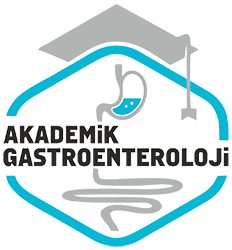Aralik 2024
Submukozal tünel ile endoskopik rezeksiyon yönteminin üst gastrointestinal kanal subepitelyal tümörlerinin tedavisindeki yeri: Tersiyer merkez deneyimi
Submucosal tunneling endoscopic resection in the treatment of subepithelial tumors of the upper gastrointestinal tract: A tertiary center experience
- Ana Sayfa
- Sayılar
- Aralik 2024
- Submukozal tünel ile endoskopik rezeksiyon yönteminin üst gastrointestinal kanal subepitelyal tümörlerinin tedavisindeki yeri: Tersiyer merkez deneyim...
Özet
Giriş ve Amaç: Submukozal tünel ile endoskopik rezeksiyon yöntemi muskularis propria tabakasindan kaynaklanan subepitelyal lezyonlarin tedavisinde seçeneklerden birisidir. Bu çalışmada üst gastrointestinal kanaldaki subepitelyal lezyonlarin tedavisinde submukozal tünel ile endoskopik rezeksiyon yönteminin etkinligi ve güvenilirligi değerlendirildi. Gereç ve Yöntem: Ocak 2020- Subat 2024 tarihleri arasında submukozal tünel ile endoskopik rezeksiyon yöntemi ile rezeke edilen Hastaların demografik verileri tarandi. Submukozal tünel ile endoskopik rezeksiyon isleme ait prosedural detaylar ile subepitelyal lezyonlarin histopatolojik verileri incelendi. çalışmanın primer sonlanim noktasi submukozal tünel ile endoskopik rezeksiyon islemi ile ilişkili teknik basari ve en bloc rezeksiyon oranlariydi. Bulgular: Toplamda 23 hastadaki 23 subepitelyal lezyon çalışmaya dahil edildi. Ortalama tümör çapi 26.78 mm idi (Aralık 10-55 mm). Lezyonlarin %56.5’si (13/23) özofagusta lokalizeydi. Ortalama islem süresi 61.82 dakikaydi (Aralık 22-132 dakika). Teknik basari orani %100’dü. En bloc rezeksiyon orani ise %86.9’dü. Per-op komplikasyon Hastaların %39.1’inde gelisti. Cerrahi tedavi gerektiren komplikasyon olmadi. Medyan hastane yatış süresi 1 gündü (Aralık 1-2 gün). Histopatolojik değerlendirmeye göre lezyonlarin 17’sine leiomyom, 4’üne gastrointestinal stromal tümör ve 2’sine ektopik pankreas tanısı kondu. Medyan 16 aylik (Aralık 6-36 ay) izlemde rekürrens gözlenmedi. Sonuç: Submukozal tünel ile endoskopik rezeksiyon yöntemi, üst gastrointestinal kanaldaki muskularis propria kaynakli subepitelyal lezyonlarin tedavisinde etkili ve güvenilir bir yöntemdir.
Abstract
Background and Aims: Submucosal tunneling endoscopic resection is one of the options in the treatment of subepithelial lesions originating from the muscularis propria layer. In this study, the efficacy and safety of submucosal tunneling endoscopic resection in the treatment of subepithelial lesions in the upper gastrointestinal tract were evaluated. Materials and Methods: Demographic data of the patients who underwent submucosal tunneling endoscopic resection between January 2020 and February 2024 were scanned. Procedural details and histopathological data of subepithelial lesions were examined. The primary endpoints of the study were the technical success and en bloc resection rates associated with submucosal tunneling endoscopic resection. Results: The study included 23 subepithelial lesions in 23 patients. The mean tumor diameter was 26.78 mm (range 10-55 mm). Thirteen (56.5%) of the lesions were observed in the esophagus. The mean procedure time was 61.82 min (range 22-132 min). The technical success rate was 100%. The en bloc resection rate was 86.9%. Per-operative complications occurred in 39.1% of the patients. No complications requiring surgical treatment occurred. The median hospital stay was 1 day (range 1-2 days). According to histopathological evaluation, 17 of the lesions were diagnosed as leiomyoma, 4 as gastrointestinal stromal tumor, and 2 as ectopic pancreas. No recurrence was observed during a median follow-up of 16 months (range 6-36 months). Conclusion: Submucosal tunneling endoscopic resection is an effective and safe treatment for the subepithelial lesions originating from the muscularis propria in the upper gastrointestinal tract



